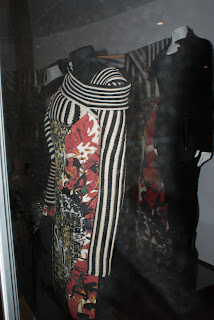I'm a V&A member and was lucky enough to have the time to go to the members preview of the new exhibition 'Ballgowns: British Glamour Since 1950' with a friend on the preview day on Friday 19th. I loved the exhibition and my friend loved it too. I bought some postcard booklets - one of selected items in the exhibition and one of images from the fashion hall. My idea was that when I got home I could select some of the items that I had postcards for and work from there.
This did not work for a few reasons.
a) The dresses I really loved were not in the postcard book (and therefor I had no image and no information on designer, fabric, year etc)
b) The dresses that I thought of selecting I couldn't remember detailing or techniques
c) I couldn't get the dresses I loved out of my head.
So luckily I was in London to meet another friend the next day, and after an enjoyable lunch, a failed attempt to get into the Da Vinci Anatomy exhibition at the Queen's Gallery (it was sold out) and a trip around the Royal Mews (complementary to the military, and my friend could come in for free too - we made up for it in the gift shop), I nipped to the V&A again!
So this time I went armed with my sketchbook, a camera for the fashion gallery (no photography in the exhibit) and a sharpened 2B. I was surprisingly not self conscious sketching in the gallery - I even saw another gentleman sketching and did notice a few glances from other strangers trying to see my drawings!
So answering the general questions posed:
Is there a theme?
Yes. Its is ballgowns since the 1950s. There were dancing dresses, red carpet dresses, evening dresses and dresses worn by royalty. On the upper floor there were contemporary dresses.
Is it well displayed?
I loved the way the fashion galleries have been reworked - especially the way images are projected onto the curves of the walls around the hall, enticing people to look up and see the architecture. The dresses were all on figures in fabulous poses, each appropriate to the era and style. There was also a video which fills you up with both humour for the 'way things were' and a wish that they were that way again!
Is the lighting appropriate?
Lighting always has to be slightly dimmed so that items aren't ruined but it was well lit enough that you wouldn't notice it was dimmed!
Is there enough explanation of the exhibits?
No! There were the occasional ditty but most dresses just had designer, year and type of fabric, occasionally season was included. One of the dresses I chose for my 'three' had a bit more and I wrote the whole thing in my notebook. More about the other dresses would have been really welcome. I felt a bit like the dresses were being treated like objects instead of real human beings* with a life and a story and a history of being worn by fabulous people to fabulous occasions and doing heroic acts... *I'm getting carried away but I did think more should be there for people who want to read about it!
Is it visually stimulating and interesting?
Definitely so. Especially the contemporary gowns on the upper level which had wonderful spheres all round the dresses which were open air so you could lean in and see every minute detail.
I actually chose 4 items but 2 were from the fashion galleries and not from the exhibit itself! But those 2 did have the advantage that I could take photos and they were both since 1950! When it comes to the questions all the dresses could be described as both functional, decorative and symbolic, dimensions are body sized and mainly abstract (though the graffiti style dress is representational of graffiti I suppose)!
To what extent to the pieces refer to tradition or another culture or a period of fashion?
What qualities do you like or dislike about the pieces?
Polka dot dress: Traditional, refers to 50s style (in 1957 so current) Love the pattern and how the fabric is sheer at the back and opaque at the front through clever layering. Love the twisted ribbon waist.
Printed latex dress: Refers to tradition in shape and the lace pattern printed on the latex but not in the fabric! Love the pattern and the technical way the dress is put together. I don't hate the dress in any way but wouldn't wear it myself without going on a starvation diet!
Appliquéd ribbon dress: Very traditional dress, I don't like the way the skirt gathers but I love the colours, the way the strips are arranged on the dress and the shaping of the shoulder.
Punk dress: Traditional shape but deliberately untraditional style. Refers to punk fashion culture. Love the wool embroidery in every way, I don't like the way the zips and buckles seem to be forcibly introduced into the design.

















































